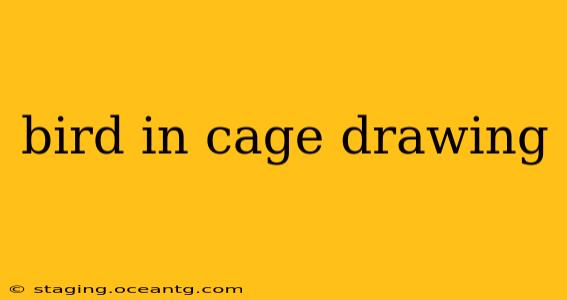Drawing a bird in a cage can be a surprisingly complex and rewarding project, offering opportunities to explore various artistic techniques and express a range of emotions. This guide will walk you through the process, from basic sketching to adding intricate details, addressing common questions and challenges along the way.
What are the Different Ways to Draw a Bird in a Cage?
The approach you take depends entirely on your skill level and artistic style. For beginners, starting with simple shapes and gradually adding details is recommended. More experienced artists might explore complex shading, perspective, and texture to create a truly captivating image. Consider these approaches:
- Realistic style: Focus on accurate anatomy, feather detail, and realistic cage construction. This requires a good understanding of perspective and light.
- Cartoonish style: Simplify the bird and cage shapes, using bold outlines and vibrant colors. This style is fun and expressive.
- Impressionistic style: Emphasize the mood and feeling rather than precise details. Use loose brushstrokes or sketchy lines to capture the essence of the scene.
- Abstract style: Explore shapes, colors, and textures without aiming for realistic representation. This allows for maximum creativity and expression.
How Do I Draw a Simple Bird in a Cage?
Let's start with a basic method suitable for beginners:
- Sketch the cage: Begin with simple geometric shapes—a rectangle for the base and vertical lines for the bars. Don't worry about perfect accuracy at this stage.
- Add the bird: Sketch the bird's basic shape within the cage. Use simple ovals for the body and head.
- Refine the details: Add the beak, eyes, wings, and tail. Consider the bird's posture—is it perched, singing, or resting?
- Add cage details: Add details to the cage, such as the door, a perch, or decorative elements.
- Refine the lines: Go over your sketch with a darker pencil to define the forms and erase unnecessary lines.
- Add shading and texture: Use shading to create depth and volume. Consider the light source and how it affects the bird and the cage.
What Materials Do I Need to Draw a Bird in a Cage?
The materials you need will depend on your preferred style and technique. However, here are some essentials:
- Drawing paper: Choose a paper weight that can handle erasing and layering.
- Pencils: A range of pencils (H for light lines, B for dark lines) allows for varying degrees of shading.
- Eraser: A kneaded eraser is ideal for lifting pencil marks without damaging the paper.
- Sharpener: Keep your pencils sharp for precise lines.
- Optional: Colored pencils, charcoal, pastels, or watercolors for adding color and texture.
What Kind of Birds Are Good to Draw in a Cage?
The choice of bird is entirely up to you, but some popular options include:
- Canaries: Their bright colors and cheerful disposition make them a classic subject.
- Parakeets/Budgies: Their smaller size and distinct markings offer a different challenge.
- Finches: Their delicate features and varied plumage provide artistic opportunities.
- Lovebirds: Their playful interaction can add a dynamic element to the drawing.
How Do I Draw Realistic Feathers?
Drawing realistic feathers requires patience and attention to detail. Observe the direction of the feathers, their overlapping patterns, and the way light reflects off their surface. Use short, delicate strokes to create the texture and avoid harsh lines.
How Can I Improve My Bird in a Cage Drawing?
Practice is key! Start with simple sketches and gradually increase the complexity. Study bird anatomy and cage construction from photographs or real life. Experiment with different techniques and materials to find your style. Don't be afraid to make mistakes; they are part of the learning process.
By following these steps and practicing regularly, you'll be able to create stunning bird-in-cage drawings that capture the beauty and emotion of this timeless subject. Remember to focus on the details that matter most to you, and let your creativity shine through.
